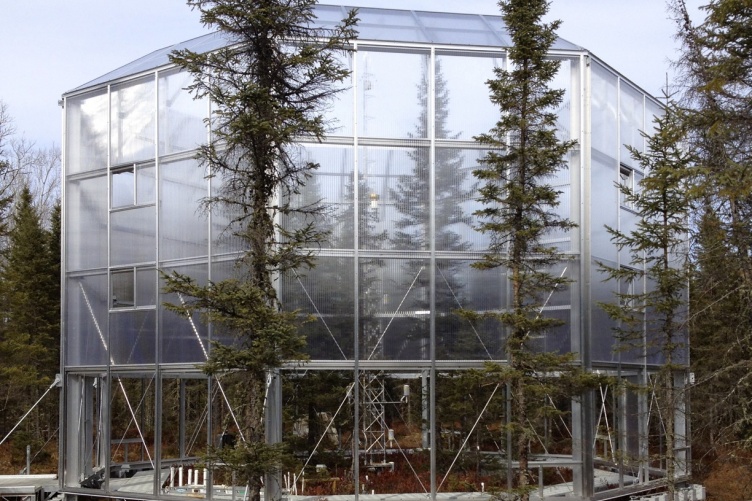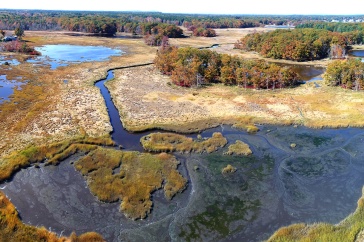
A new study used 12-meter tall enclosures in a peat bog to measure vegetation changes brought on by drier soil from climate change. Photo by Paul Hansen/DOE.
In peat bogs around the world, shrubs are thriving and replacing moss — a groundcover transformation brought on by climate change, and one that could add even more carbon dioxide into our atmosphere, according to a new study.
The research indicates that shrubs like wild blueberry plants are adapting to drier conditions in peatlands, a type of wetland ecosystem that stores vast amounts of the Earth’s carbon and is highly vulnerable to the impacts of climate change. Scientists are calling this phenomenon the “shrubification” of peatlands, and they’re warning that it could potentially contribute to rising levels of greenhouse gas emissions.
“Warmer temperatures from climate change could dry out these peatlands further, thus exposing the carbon-rich peat to oxygen, enhancing decomposition and then releasing large amounts of carbon dioxide,” explains Erik Hobbie, a research professor at the UNH Earth Systems Research Center (ESRC) and co-author on the study published in the Proceedings of the National Academy of Science. The research was funded by the U.S. Department of Energy’s Office of Science and led by Oak Ridge National Laboratory in Oak Ridge, Tennessee.
"Warmer temperatures from climate change could dry out these peatlands further, thus exposing the carbon-rich peat to oxygen, enhancing decomposition, and then releasing large amounts of carbon dioxide."
Hobbie’s research focuses on the belowground environment, which is a source for the nutrients and water plants need for growth; it’s also where a large portion of the Earth’s carbon is stored — even more than in our atmosphere — so how the belowground environment responds to climate change will influence plant responses, he says.
Plant roots play a major role in regulating the carbon, water and other nutrient cycles. In this study, scientists studied fine roots — those smaller than 2 millimeters in diameter that grow and die off rapidly, which means they respond quickly to environmental change and thus are leading indicators of how plants will respond to climate change, Hobbie explains.
The scientists set up 12-meter octagonal enclosures on peatlands in northern Minnesota, leaving the tops open to allow normal precipitation and temperature patterns. Within the enclosures, they maintained belowground and air temperatures at 0 °C to 9 °C above ambient levels and measured the fine-root growth in peatland shrubs. To acquire the nutrients and water needed in these warmer and drier soil conditions, root growth of shrubs increased dramatically, by 130% for each degree of warming.
“Soil moisture levels play a key role in determining the growth of fine roots,” Hobbie says. “One consequence of warming is an extended growing season, which allows plants more time to ‘wick’ moisture from the soil into the atmosphere, also known as transpiration. This could dry out the soil and further enhance shrub growth, which could increase the turnover of peatland carbon into atmospheric carbon dioxide.”
Although peatlands cover a mere one percent of New Hampshire, the worldwide sum of this shrubification could add up to some significant changes. However, Steve Frolking, a research professor at the UNH ESRC who was not involved in this study, cautions that it’s extremely difficult to make confident predictions about the likelihood or degree of peatland drying that might occur in the future.
“In this study, the fine-root response was mostly due to drying — not from warmer temperatures or an increase in atmospheric carbon dioxide,” Frolking says. “Drying and warming can be related, but they don’t have to be; it could get warmer and not drier, if precipitation increases enough to offset increased evapotranspiration. Predicting changes in precipitation and ecosystem moisture status is much more difficult and uncertain than predicting changes in temperature.”
Both Hobbie and Frolking emphasize the need for further studies of plant roots to more accurately assess their changes in all types of conditions.
“Roots are essential to the function, health, and productivity of rooted plants, but they are so much harder to observe and study than leaves, stems, and flowers, so we know very little about them,” Frolking adds.
The Institute for the Study of Earth, Oceans, and Space (EOS) is UNH's largest research enterprise comprising six centers with a focus on interdisciplinary, high-impact research on Earth and climate system, space science, the marine environment, seafloor mapping, and environmental acoustics. With more than $58 million in external funding secured annually, EOS fosters an intellectual and scientific environment that advances visionary scholarship and leadership in world-class resaerch and graduate education.
-
Written By:
Rebecca Irelan | Institute for the Study of Earth, Oceans, and Space | rebecca.irelan@unh.edu | 603-862-0990

















































